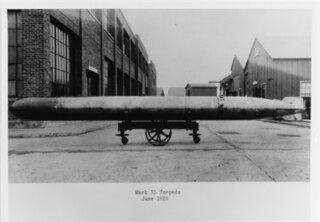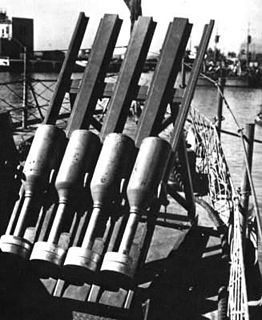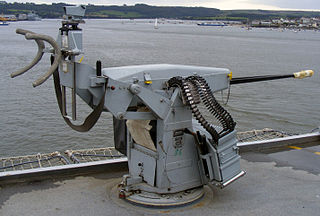 W
WThe 320 mm naval gun was the main battery gun used to modernize Italy's World War I battleships for service during World War II. The guns were manufactured by boring out and relining the battleships' original 12"/46 (30 cm) built-up guns and modifying the turrets to increase elevation above the original 20° maximum. Each ship carried two 548-tonne twin turrets and two 745-tonne triple turrets. All guns used pneumatically operated side-swing Welin breech blocks. Each barrel could fire two rounds per minute.
 W
WThe Bliss–Leavitt Mark 8 torpedo was the United States Navy's first 21-inch by 21-foot torpedo. Although introduced prior to World War I, most of its combat use was by PT boats in World War II. The torpedo was originally designed in 1911 by Frank McDowell Leavitt of the E. W. Bliss Company and entered full mass production in 1913 at the Naval Torpedo Station in Newport, Rhode Island. It was deployed on destroyers and battleships during World War I and cruisers built in the 1920s. All US battleships and most cruisers had their torpedo tubes removed by 1941. The Mark 8 remained in service through World War II on older destroyers, primarily the Wickes and Clemson classes. It also equipped PT boats early in World War II, but was replaced by the Mark 13 torpedo on most of these in mid-1943.
 W
WThe Bofors 40 mm gun, often referred to simply as the Bofors gun, is an anti-aircraft autocannon designed in the 1930s by the Swedish arms manufacturer AB Bofors. It was one of the most popular medium-weight anti-aircraft systems during World War II, used by most of the western Allies as well as some captured systems being used by the Axis powers. A small number of these weapons remain in service to this day, and saw action as late as the Persian Gulf War.
 W
WThe QF 3-pounder Hotchkiss or in French use Canon Hotchkiss à tir rapide de 47 mm were a family of long-lived light 47 mm naval guns introduced in 1886 to defend against new, small and fast vessels such as torpedo boats and later submarines. There were many variants produced, often under license which ranged in length from 32 to 50 calibers but 40 caliber was the most common version. They were widely used by the navies of a number of nations and often used by both sides in a conflict. They were also used ashore as coastal defense guns and later as an anti-aircraft gun, whether on improvised or specialized HA/LA mounts.
 W
WThe Canon de 75 mm modèle 1924 was a French naval anti-aircraft gun designed after World War I. It served aboard battleships, cruisers and destroyers during World War II.
 W
WThe Canon de 138 mm Modèle 1927 was a medium-calibre gun of the French Navy used during World War II. It was derived from a German World War I design. It was used on the minelaying cruiser Pluton, the destroyers of the Aigle and Vauquelin classes and the Bougainville-class sloops.
 W
WThe Canon de 138 mm Modèle 1929 was a medium-calibre naval gun of the French Navy used during World War II. It was used on the large destroyers (contre-torpilleurs) of the Le Fantasque and Mogador classes.
 W
WThe Department of Miscellaneous Weapons Development (DMWD), also known as the Directorate of Miscellaneous Weapon Development and colloquially known as the Wheezers and Dodgers, was a department of the British Admiralty responsible for the development of various unconventional weapons during World War II.
 W
WThe Hedgehog was a forward-throwing anti-submarine weapon that was used primarily during the Second World War. The device, which was developed by the Royal Navy, fired up to 24 spigot mortars ahead of a ship when attacking a U-boat. It was deployed on convoy escort warships such as destroyers and corvettes to supplement the depth charges.
 W
WThe Johore Battery was a former British coastal artillery battery located in Changi on the easternmost side of mainland Singapore. It consisted of three large BL 15-inch Mk. I naval guns installed on land by the British government in the late 1930s to defend the approaching path to the east of the island to their large naval base located at Sembawang in the north from an attacking enemy naval force.
 W
WThe Mark 6 exploder was a United States Navy torpedo exploder developed in the 1920s. It was the standard exploder of the Navy's Mark 14 torpedo.
 W
WThe Mark 11 torpedo was the first American torpedo to be designed totally within the United States Navy without collaboration from industry. It was developed by the Washington Navy Yard in Washington, D.C. and the Naval Torpedo Station in Newport, Rhode Island. The Mark 11 torpedo was also the first to feature a three-speed setting capability while tube-loaded: high at 46 knots, medium at 34 knots and low at 27 knots. Due to stability problems it was supplemented by the Mark 12 torpedo within two years, which had a 44-knot high speed setting.
 W
WThe Mark 13 torpedo was the U.S. Navy's most common aerial torpedo of World War II. It was the first American torpedo to be originally designed for launching from aircraft only. They were also used on PT boats.
 W
WThe Mark 14 torpedo was the United States Navy's standard submarine-launched anti-ship torpedo of World War II. This weapon was plagued with many problems which crippled its performance early in the war. It was supplemented by the Mark 18 electric torpedo in the last two years of the war. Nonetheless, the Mark 14 played a major role in the devastating blow U.S. Navy submarines dealt to the Japanese naval and merchant marine forces during the Pacific War.
 W
WThe Mark 15 torpedo, the standard American destroyer-launched torpedo of World War II, was very similar in design to the Mark 14 torpedo except that it was longer, heavier, and had greater range and a larger warhead. It was developed by the Naval Torpedo Station Newport concurrently with the Mark 14 and was first deployed in 1938. It replaced the Mark 8 torpedo on surface ships with tubes that could accommodate the longer Mark 15; this primarily included destroyers built after 1930. Older destroyers, primarily the Wickes and Clemson classes, continued to use the Mark 8, as did PT boats early in World War II. During the war 9,700 were produced at Newport and at the Naval Ordnance Station Forest Park, Illinois.
 W
WThe Mark 18 torpedo was an electric torpedo used by the United States Navy during World War II. The Mark 18 was the first electric storage battery torpedo manufactured for the US Navy and it was designed primarily for use as a submarine-launched torpedo.
 W
WThe Mark 24 mine is an air-dropped anti-submarine warfare weapon (ASW) incorporating passive acoustic homing system and torpedo integration. It was used by the United States, the British and Canadian forces during the Second World War and entered service in March 1943 and remained in use with the US Navy until 1948. Approximately 4,000 torpedoes were produced, with 340 ultimately being deployed during the war. 204 torpedoes were launched against submarine targets, with 37 Axis submarines being sunk and a further 18 damaged. The deceptive name of "Mark 24 Mine" was deliberately chosen for security purposes, to conceal the true nature of the weapon.
 W
WMousetrap was an anti-submarine rocket used mainly during the Second World War by the U.S. Navy and the U.S. Coast Guard. Its development was begun in 1941 as a replacement for Hedgehog, a British-made projector, which was the first ahead-throwing ASW weapon. These, however, were spigot-launched, placing considerable strain on the launching vessel's deck, whereas Mousetrap was rocket-propelled. As a result, Mousetrap's four or eight rails for 7.2-inch (183 mm) rockets saved weight and were easier to install.
 W
WThe Oerlikon 20 mm cannon is a series of autocannons, based on an original German Becker Type M2 20 mm cannon design that appeared very early in World War I. It was widely produced by Oerlikon Contraves and others, with various models employed by both Allied and Axis forces during World War II, and many versions are still in use today.
 W
WShip gun fire-control systems (GFCS) are analogue fire-control systems that were used aboard naval warships prior to modern electronic computerized systems, to control targeting of guns against surface ships, aircraft, and shore targets, with either optical or radar sighting. Most US ships that are destroyers or larger employed gun fire-control systems for 5-inch (127 mm) and larger guns, up to battleships, such as Iowa class.
 W
WThe Škoda 7 cm K10 was a dual-purpose gun of the Austro-Hungarian Empire that was used by the Austro-Hungarian Navy during World War I. The gun was actually 66 mm, but the classification system for artillery rounded up to the next highest centimeter. The 7 cm K10 was also used by the Italian Navy on ships ceded as war reparations and as coastal artillery during World War II. The Italians referred to it as the 66/47.
 W
WThe Škoda 10 cm K10 was a 100 mm (3.9-inch) naval gun of the Austro-Hungarian Navy used as tertiary armament on semi-dreadnought battleships and as primary armament on scout cruisers and destroyers during World War I. After World War I, variants of the Škoda 10 cm K10 were widely produced in Italy as the 100/47 series of guns, which served in a number of roles, on a wide variety of ships, with a number of navies.
 W
WThe Type 91 was an aerial torpedo of the Imperial Japanese Navy. It was in service from 1931 to 1945. It was used in naval battles in World War II and was specially developed for attacks on ships in shallow harbours.
 W
WThe Type 93 was a 610 mm (24 in)-diameter torpedo of the Imperial Japanese Navy (IJN), launched from surface ships. It is commonly referred to as the Long Lance by most modern English-language naval historians, a nickname given to it after the war by Samuel Eliot Morison, the chief historian of the U.S. Navy, who spent much of the war in the Pacific Theater. In Japanese references, the term Sanso gyorai is also used, in reference to its propulsion system. It was the most advanced naval torpedo in the world at the time.
 W
WThe Type 95 torpedo was a torpedo used by submarines of the Imperial Japanese Navy during World War II.